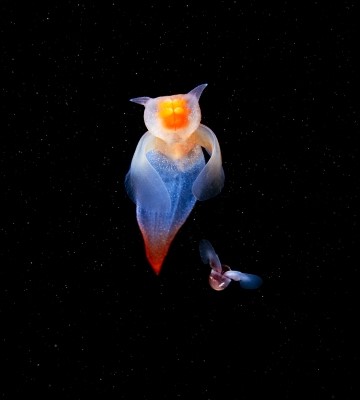720524_Sea Angels_360 px width_cropped.jpg

A sea angel (left) with it's prey of choice, the sea butterfly (right). Credit: Alexander Semenov, CC BY-NC-SA 2.0
Some tiny sea snails may look like angels, but they act more like little devils. They rip their favorite prey from their shells. And the prey just happens to be a relative.
Sea angels are found around the world, from the arctic to the tropical waters near the equator. Most range from the surface to depths of a couple of thousand feet, although some have been seen more than a mile down.
Sea angels are born with shells, but they lose them as they become adults. They’re no more than a couple of inches long, and they have streamlined bodies. They’re mostly transparent, which helps them hide from predators. The Antarctic sea angel has extra protection: it produces a nasty chemical that keeps most predators away.
What gives sea angels their “angelic” appearance is a pair of wings. They’re adapted from the muscular foot of their land-based cousins. The creatures move through the water by flapping those wings. They can move twice as fast as their prey.
Their favorite treat is another sea snail—the sea butterfly. Some angels lie in wait, while others are more active hunters. They grab their prey with small tentacles that extend from the head. Hooks allow them to pull the butterfly from its shell in as little as two minutes.
Sea angels and their prey are jeopardized by climate change, which makes the oceans more acidic—a hazard for any creature that produces a shell. That’s an extra challenge for these angelic little devils flapping through the world’s oceans.

